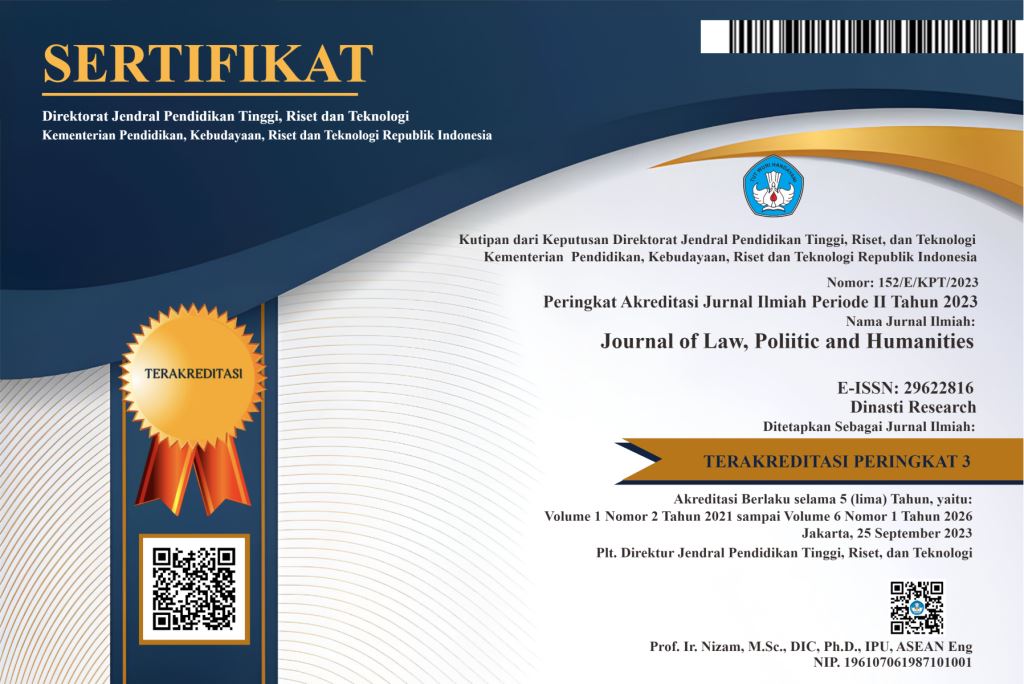Juridical Review Of The Case Of Alleged Plagiarism Of The Song "Apa Sih" By The Band Radja Against The Song "APT" By Rosé BLACKPINK Feat. Bruno Mars According To Law Number 28 Of 2014 Concerning Copyright.
DOI:
https://doi.org/10.38035/jlph.v5i6.2308Keywords:
Copyright, Plagiarism, IPR, Song, Law No. 28 of 2014, Legal SanctionsAbstract
This research is a juridical perspective on the case of alleged plagiarism of the song "Apa Sih" owned by Radja Band against the song "APT" owned by Rosé BLACKPINK feat. Bruno Mars within the framework of Law Number 28 of 2014 concerning Copyright. The development of digital technology has revolutionized the music industry, making it easier to reproduce and distribute works, and increasing the risk of copyright infringement. Plagiarism in musical works-including melodies, arrangements, lyrics, and audiovisual elements-is a copyright infringement that is legally categorized as a tort. This research uses a normative juridical method by analyzing statutory provisions, particularly Law No. 28 of 2014, to assess the scope of protection for musical and audiovisual works, as well as to examine the legal implications of alleged unauthorized duplication. The results show that there are significant similarities in the musical and visual components of the two songs that can be interpreted as a violation of the creator's economic and moral rights. Although the legal framework has provided strong protection, the implementation of copyright in the field still faces various challenges, such as subjectivity in assessing musical similarity, low public legal awareness, and the need for clear standards of proof. This research recommends strengthening the implementation of copyright law, public education related to intellectual property rights, and stricter supervision of digital platforms to maintain the originality of copyrighted works.
References
ADCO Law. (2025, 31 Oktober). Bentuk-Bentuk Penerapan Sanksi Hukum https://adcolaw.com/id/blog/bentuk-bentuk-penerapan-sanksi-hukum/
Benuf, Kornelius, & Muhamad Azhar, (2020). Metodologi Penelitian Hukum Sebagai Instrumen Mengurai Permasalahan Hukum Kontemporer. 07(1). 5.
Crismantara, I. B. N. A., & Dewi, N. K. R. K., (2021). Tinjauan Yuridis Undang-Undang Nomor 28 Tahun 2014 Tentang Hak Cipta Terhadap Karya Cipta Lagu Yang Diaransemen Ulang Tanpa Izin Pencipta”, Jurnal Hukum. 01(02).
Deepublish. (2023, 8 September). Plagiarisme: Ruang Lingkup, Tipe, Cara Pencegahan, Sanksi. Plagiarisme: Ruang Lingkup, Tipe, Cara Pencegahan, Sanksi
INFOHUKUM. (2025, 18 Januari). Sanksi-Sanksi Hukum Perdata Indonesia: Jenis dan Pengertiannya. https://fahum.umsu.ac.id/info/sanksi-sanksi-hukum-perdata-indonesia-jenis-dan-pengertiannya/
IrkaMedia, (2023, 3 Maret). Transformasi Industri Musik Dari Awal Ke Era Digital. https://www.indonesiana.id/read/162348/transformasi-industri-musik-dari-awal-ke-era-digital
Riswandi, Budi Agus. (2009). Hak Cipta Di Internet: Aspek Hukum Dan Permasalahannya Di Indonesia. Yogyakarta : FH UII Press, s.a.
Saidin, O.K. (2007). Aspek Hukum Hak Kekayaan Intelektual: Intellectual Property Right. Jakarta: Rajawali Pers.
Soekanto, Soerjono & Sri Mamuji. (2001). Penelitian Hukum Normatif (Suatu Tinjauan Singkat, Rajawali Pers, Jakarta.
Soelistyo Herry, (2011). Pelanggaran hak Cipta dan Etika. Yogyakarta Kanisius, 17.
Sutedi, Adrian (2009). Hak Atas Kekayaan Intelektual. Jakarta: Sinar grafika.
Syarifuddin. (2013). Perjanjian Dan Pendaftaran Hak Cipta. P.T Alumni, Bandung.
Undang-Undang Republik Indonesia Nomor 28 Tahun 2014 Tentang Hak Cipta.
Downloads
Published
How to Cite
Issue
Section
License
Copyright (c) 2025 Indra Lasmana, Mulida Hayati, Elin Sudiarti

This work is licensed under a Creative Commons Attribution 4.0 International License.
Authors who publish their manuscripts in this journal agree to the following conditions:
- The copyright on each article belongs to the author(s).
- The author acknowledges that the Journal of Law, Poliitic and Humanities (JLPH) has the right to be the first to publish with a Creative Commons Attribution 4.0 International license (Attribution 4.0 International (CC BY 4.0).
- Authors can submit articles separately, arrange for the non-exclusive distribution of manuscripts that have been published in this journal into other versions (e.g., sent to the author's institutional repository, publication into books, etc.), by acknowledging that the manuscript has been published for the first time in the Journal of Law, Poliitic and Humanities (JLPH).


























